LEGO Ideas 21325 Medieval Blacksmith – the Black Falcons return to LEGO Castle [Review]
LEGO has continued to diversify the products that it sources and launches via its LEGO Ideas platform, which for many years has been perceived as focusing on licensed themes like Ghostbusters, Doctor Who, Voltron, and so on. But increasingly, LEGO has approved wholly original designs, such as 21310 Old Fishing Store. Yesterday, LEGO officially revealed 21325 Medieval Blacksmith, an original design by LEGO fan designer Clemens Fiedler. The set includes 2,164 pieces with 4 minifigures, and will become available on February 1st, 2020 at a price of US $149.99 | CAN $199.99 | UK £134.99..
The LEGO Group provided The Brothers Brick with an early copy of this set for review. Providing TBB with products for review guarantees neither coverage nor positive reviews.
The box, packaging, and printed parts
Not counting the gorgeous 40448 Vintage Car gift with purchase from the first half of January, the blacksmith shop is the first LEGO Ideas product released in 2021. The new packaging design announced last May is clearly here to stay, with a black background that highlights the main build on the front and detail views on the back.


The set’s 2,000+ pieces come in 14 numbered bags, plus an unnumbered bag with large plates, and the instruction booklet in its own sleeve.
The instruction booklet follows the same design aesthetic, providing a page highlighting the winning fan designer and another spread for the (costumed) in-house LEGO set designers. I’m going to say something potentially controversial: More than a decade since LEGO launched the predecessor of today’s LEGO Ideas on the Japanese CUUSOO platform, both fan designer and in-house designer write-ups have started to sound pretty much all the same. I’m incredibly happy for Clemens, but his story is the same as just about every other winning fan designer (a big fan of LEGO theme XYZ since childhood, follow your dreams, etc.), while the in-house designers of the actual product similarly sound much the same (privileged to work on the fan designer’s wonderful design, etc.).
I appreciate that the individual designers continue to take center stage in LEGO’s instructions for sets geared toward older builders — a number of my own LEGO friends have successfully earned 10,000 votes on LEGO Ideas, and several more are designers of official sets in Billund. But these write-ups have become so templatized that reading them adds very little to the build experience. But maybe I’m jaded after 11 years of LEGO CUUSOO/Ideas.
The set includes no stickered elements, with all of the detailed designs being either brick-built or printed. Two of the printed tiles are new for 2020. The 2×4 sign tile is unique to this set, and the 1×4 plank tiles are actually a new design, subtly different from previous designs. We’ve seen compass, target, and “Once upon a time…” tiles previously, but more of these unusual printed elements is always welcome.
The build
Hobbyist builders have been creating structures on bases other than, well, baseplates for years, but most larger LEGO buildings like Modulars still start on 32×32 or 16×32 baseplates. True to its origins as a fan design, the blacksmith shop starts on an irregular base built from plates. Rounded corners soften the building’s footprint, with sections that extend out from the main base to accommodate the blacksmith’s working area and the well with a tree.


The blacksmith’s workshop is on the ground floor, full of excellent details beyond the requisite forge, including a grinding wheel. Landscaping begins coming together beautifully, taking advantage of the varied colors and surface textures in the underlying plates and tiles.


LEGO is leaning hard into foliage these days, from the beautifully autumnal tree in last year’s 10270 Bookshop modular building to Nick Vas’s stunning trees in Ninjago City and this year’s 10281 Bonsai Tree.
I’m less convinced by the apple tree in this set, which has exposed black roots, and whose four sub-assembly branches look much more obviously identical to each other. Nevertheless, as a background detail with the focus on the main building, I think it does work.
After the stonework and landscaping of the ground level, the middle story is where the blacksmith’s medieval heritage shines. Brown bricks with studs facing out sit between white wall (infill) sections, providing attachment points for both straight and curved brown tiles, serving as vertical timbers and braces. All together, these create a wonderfully textured, three-dimensional look that’s much more than a flat wall that’s mostly white and a bit brown. My favorite details are the jetty brackets and external posts that support the growing footprints of the middle story and the attic.
Although a good bit of the square footage is used up by the stairs to the top floor, the middle floor includes a kitchen and dining area with fantastic brick-built chairs. Notice the hatchets used as the stiles on the chairs. I especially love the butter churn, which has a 1×1 round brick attached to the bar piece inside the barrel, allowing the handle to move around without falling out. I churned a bit of imaginary butter for a moment or two as I built my blacksmith’s living area.
The top floor has the largest footprint, supporting the very large roof. Like the blacksmith shop on the ground floor and dining room on the middle floor, the attic is full of great detail, with a beautiful bed and writing area.
The bed deserves particular attention, standing in stark contrast to the bunks and berths I’m using to building in Star Wars sets like every Millennium Falcon. The bed has a checkered three-color bedspread, tan bedding, and white pillows. But check out the bed’s footboard! It’s the face of an adorable bear.
But the cute, carved wooden bear on the bed isn’t the only bear in the attic. There’s a black bearskin rug on the floor of the attic, which I’m not sure I like. I’m no animal rights militant (although I’m a lifelong vegetarian), but the preserved carcass of a fairly rare animal feels like an odd decorative detail in a LEGO set, as well-executed as it is from a pure design standpoint, and as realistic as it might feel in the home of a huntress (she’s the one who brings in the literal bacon, I imagine, when she bags a boar).
The building’s colorful roof is incredibly parts intensive, with two of last three bags dedicated to each half of the roof. The sheer number of Nexo shields in three colors will certainly please builders who appreciate the use of large number of the same part to create interesting textures.
The roof sections slot into panels on the attic floor, holding the roof securely in place while allowing one half to detach easily enough to access the interior. Again, if you want a giant pile of Nexo shields in three colors, this set is for you.
The final bag includes the parts for the wagon, with the new tan horse. We’ll take a closer look at both of these later in this review.
The finished model
My favorite LEGO Castle sub-theme was Forestmen, which integrated ruinous structures into a natural landscape. I would spend days integrating huge, ruinous castles of my own into as much green as I could get my hands on (remember when green was a fairly rare color in LEGO?). I replaced the Black Falcons and Lion Knights that came with my sets with more Forestmen cobbled together from other minifigs. Today, fantasy-oriented LEGO builders have been creating seemingly impossible builds in a tumbledown, ramshackle style that I’ve never been entirely a fan of personally, but whose craft and artistry I certainly respect. The new LEGO Ideas set 21325 Medieval Blacksmith brings elements of this style into the official LEGO mainstream.
True to the design aesthetic that emerged among hobbyist LEGO builders, no surface is without detail. The stonework ground floor includes tiles at each corner, as well as over each doorway.
The half-timber design is particularly stunning, as we saw during the build process earlier in the review. Again, the timbers extend beyond just brown verticals within the wall, with supports for upper floors and a variety of brackets and braces.
We saw some of the interior details during the build overview above, but the interior is no less chock-full of all the accoutrements of a blacksmith, from the workshop on the ground floor to the bedroom in the attic. Inside the workshop, there’s an anvil with an orange ingot, a pile of coal, and a variety of metalwork products from pauldron armor on a rack to a cooking pot, pan, and pot helm.
Easily my favorite detail in the whole set is the forge. Pushing a brick-built bellows on the outside of the building presses the button on a light brick, making the coals glow. Lighting up the coals in the forge with a bellows is both obvious and utterly brilliant.
The forge area features an anvil, barrel for cooling the ironwork, and a clip to set the piece you’re working on over the coals.
The cooking and dining area on the middle floor includes the wonderful chairs and butter churn we saw earlier, along with a cooking area that has a carrot mid-prep, complete with a slice cut off (an orange 1×1 round tile).
As wonderful as the bear bed is on the top floor, there’s also a nice writing area — apparently this medieval blacksmith is literate!
For a bit of added realism, the set includes a wagon with a horse. The back of the wagon uses 1×4 fence pieces for the slats, with wooden palisade bricks below. While the nougat-colored bricks certainly add a spot of different color, the whole wagon feels far too tall, and to add insult to inevitable workplace injury, there’s no gate at the back to add cargo.
Nitpicks with dead bear rugs and overly tall wagons aside, the set taken as a whole is truly gorgeous, providing an enjoyable build that adds interesting details at every step.
The minifigures
The LEGO Shop page’s description identifies the four minifigs included with this set as the blacksmith, an archer, and two Black Falcon Knights. They’re joined by a Siberian husky-style dog (which seems a bit of an odd choice, but perhaps the German shepherd design has been retired).
The blacksmith himself sports a shock of red hair and an equally shocking red beard, but it’s his torso and legs that pull together the overall blacksmith look, with a leather apron that extends down onto the legs. The archer wears less occupationally specific clothing, which should be useful for populating medieval towns and farms of your own. Of particular note is that she has dual-molded legs, with brown boots. Both minifigs have reversible heads with alternative expressions on both sides. I love the look of concentration on the blacksmith’s face, even though the “concentration tongue” wouldn’t be visible under his beard. Similarly, the archer has a winking face, as though she’s aiming her bow.


The two Black Falcons have identical torsos and legs, with a hauberk under a tunic that extends down onto the legs. The older male knight sports a bowl cut that looks perfect on a medieval minifig, while the female knight leans into her ahistorical nature with a headband and tousled hairstyle. They wield different weapons and pauldron styles, but both have pot helmets like the one the blacksmith is working on in his shop.


One of the reasons Black Falcons have always been popular among LEGO Castle fans is their excellent heraldry (though between Black Falcons and the Lion Knights I personally preferred the latter, which reminded me of C.S. Lewis’ descriptions of Narnian heraldry). The original Black Falcons coat of arms frankly looked a bit like a pigeon, with a rounded head and splayed wings, as we can see when comparing it to the 2012 version that appeared in 10223 Kingdoms Joust and the truly badass bird of prey in this latest set. This is the Black Falcons design we all think was on the original shields, in a haze of nostalgia.
Graphic design for minifigures has indeed come a long way in 35 years, with many more printed colors and much higher detail. It’s probably heresy to say this among the nostalgists reading my review, but I’ll take a 2021 minifig over a 1984 minifig any day.
LEGO Castle fans (and fans of LEGO animals more generally) always get excited about a new horse design. White and black horses have been moderately common over the years, so a tan horse comes as a welcome change — equine diversity is important. The bridle design is excellent, but that is likely to draw less attention than the horse’s overall color. As always, extra bricks are provided to fill in the horse’s back when it’s not pulling the wagon.
Conclusions & recommendation
I wasn’t one of the LEGO fans who took up virtual arms when the final set design was revealed recently. LEGO Ideas designs go through years of iteration to productize the fan designer’s original work, as laudable as it may be. Clemens’ original design was indeed great, but this process is entirely expected and the outcomes understandable. Given that, I’m appreciating the set as a LEGO set, not comparing and contrasting it with Clemens’ virtual build that earned 10,000 votes a couple years ago.
While I’m less-impressed with some the secondary details like the tree and wagon, the main building is truly excellent, from the stonework ground level to the half-timber middle level and the attic under the slate roof.
At $150 for over 2,000 parts, including four great minifigs and two animals (larger animals always almost always increase the price of LEGO sets), the set is also a pretty great deal. The set provides a range of very useful parts for architecturally oriented builders, and I’d love to see alternative builds using nothing but the parts in this set.
Whether you’re more nostalgic for Forestmen or Lion Knights (or later factions like Dragon Knights) than you are for Black Falcons, this is an excellent set that any LEGO Castle fan should appreciate.
LEGO Ideas 21325 Medieval Blacksmith includes 2,164 pieces with 4 minifigures, and will be available on February 1st from the LEGO Shop (US $149.99 | CAN $199.99 | UK £134.99.), Amazon.com, and elsewhere, including third-party sellers from eBay.












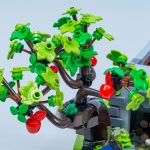

















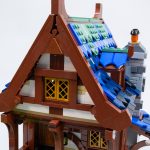




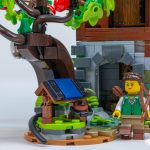



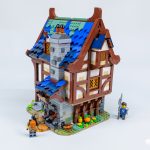








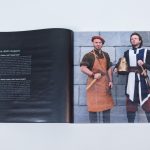





The post LEGO Ideas 21325 Medieval Blacksmith – the Black Falcons return to LEGO Castle [Review] appeared first on The Brothers Brick.





























